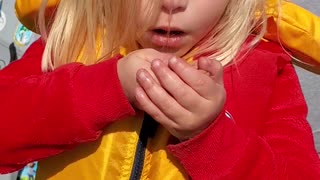Premium Only Content

Dolphin kisses a little girl and brings her a gift
An adorable little girl kisses the Dolphins.
As the crowd watches on an adorable little girl in a small orange and white boat with the supervision of a woman. She greets the dolphins as they swim up to meet her. The little girl leans over and gave the dolphins a lovely greeting. The dolphins show their appreciation by bringing a gift to the beautiful little girl and gets a kiss from her, it's a heartwarming event that you have to see for yourselves.
Dolphins are small-toothed cetaceans easily recognizable by their curved mouths, which give them a permanent “smile.” There are 36 dolphin species, found in every ocean. Most dolphins are marine and live in the ocean or brackish waters along coastlines. There are a few species, however, like the South Asian river dolphin and the Amazon river dolphin, or boto, that live in freshwater streams and rivers.
The largest dolphin, the orca, can grow to be over 30 feet long. The smallest, the Maui dolphin, is just five feet long.
Dolphins feed chiefly on fish and squid, which they track using echolocation, a built-in sonar that bounces sound waves off prey and reveals information like its location, size, and shape. An echolocating bottlenose dolphin can make up to a thousand clicking noises per second.
Behavior and reproduction
Living in pods that can number a dozen or more, dolphins are intensely social mammals that communicate with squeaks, whistles, and clicks. Whether dolphins have language, as humans do, is a topic that scientists have debated for decades.
As mammals, they have warm blood and nurse their young. Dolphins have more than one mate, and generally produce a single offspring that will stay with the mother for up to six years, depending on the species.
Dolphins are graceful, sleek swimmers that can reach speeds of more than 18 miles an hour. They are also playful and often frolic in a boat’s wake, leaping out of the water—possibly for fun, to communicate, or even shed pesky parasites.
Threats
For centuries, people have hunted dolphins for their meat and blubber. Today, their main threat comes from being caught accidentally in commercial fishing nets. Dolphins must rise regularly to the surface to breathe—becoming entangled in nets prevents this, leading to drowning. For maine dolphins, warming ocean temperatures because of climate change have caused some of their primary food sources to move into deeper, cooler water. Furthermore, marine heatwaves, also caused by climate change, appear to have a negative affect on dolphins' reproductive rates and ability to survive.
In addition to hunting and entanglement in fishing gear, freshwater dolphins face the additional threat of dams fragmenting and degrading habitat.
-
 0:18
0:18
x4xbazzyx4x
3 years agoLittle Girl Kisses Worm and throws Him in the Water
481 -
 3:21:56
3:21:56
Tate Speech by Andrew Tate
9 hours agoEMERGENCY MEETING EPISODE 93 - ME TOO!
152K95 -
 3:21:42
3:21:42
FRENCHY4185
5 hours agoPRESTIGE AND CAMO GRIND : BLACK OPS 6
32.9K -
 1:29:47
1:29:47
Real Coffee With Scott Adams
5 hours agoEpisode 2669 CWSA 11/24/24
30.6K24 -
 13:52
13:52
Hershberger's Kitchen
16 hours agoTwo Delicious Dip and Spread Recipes to Try, Inspirational Thought
25.9K2 -
 3:41:05
3:41:05
Sacred Sage
8 hours ago $2.87 earnedDaz3D: Attempting to Finish Zoe Conversation!
26.1K1 -
![[Stream #19 ] Gaming, Chatting, you know the drill!](https://1a-1791.com/video/s8/1/9/o/E/e/9oEeu.0kob-small-Stream-Sour-Pickle-100-Foll.jpg) LIVE
LIVE
OneRandomDolly
5 hours ago[Stream #19 ] Gaming, Chatting, you know the drill!
352 watching -
 11:07
11:07
TimcastIRL
1 day agoElon Musk Suggests He’ll BUY MSNBC, Joe Rogan Will REPLACE Rachel Maddow
67.4K52 -
 34:24
34:24
The Rubin Report
23 hours agoFormer CEO: The Aftermath of Vice Media & What's Next for Mainstream Media | Shane Smith
82.7K36 -
 9:14:23
9:14:23
tacetmort3m
2 days ago🔴 LIVE - BECOMING THE UNTOUCHABLE (RADIATION WHO?) - STALKER 2 - PART 3
32.9K6